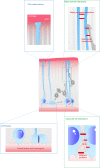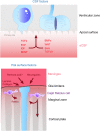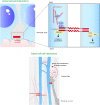Extracellular Control of Radial Glia Proliferation and Scaffolding During Cortical Development and Pathology
- PMID: 33178693
- PMCID: PMC7596222
- DOI: 10.3389/fcell.2020.578341
Extracellular Control of Radial Glia Proliferation and Scaffolding During Cortical Development and Pathology
Abstract
During the development of the cortex, newly generated neurons migrate long-distances in the expanding tissue to reach their final positions. Pyramidal neurons are produced from dorsal progenitors, e.g., radial glia (RGs) in the ventricular zone, and then migrate along RG processes basally toward the cortex. These neurons are hence dependent upon RG extensions to support their migration from apical to basal regions. Several studies have investigated how intracellular determinants are required for RG polarity and subsequent formation and maintenance of their processes. Fewer studies have identified the influence of the extracellular environment on this architecture. This review will focus on extracellular factors which influence RG morphology and pyramidal neuronal migration during normal development and their perturbations in pathology. During cortical development, RGs are present in different strategic positions: apical RGs (aRGs) have their cell bodies located in the ventricular zone with an apical process contacting the ventricle, while they also have a basal process extending radially to reach the pial surface of the cortex. This particular conformation allows aRGs to be exposed to long range and short range signaling cues, whereas basal RGs (bRGs, also known as outer RGs, oRGs) have their cell bodies located throughout the cortical wall, limiting their access to ventricular factors. Long range signals impacting aRGs include secreted molecules present in the embryonic cerebrospinal fluid (e.g., Neuregulin, EGF, FGF, Wnt, BMP). Secreted molecules also contribute to the extracellular matrix (fibronectin, laminin, reelin). Classical short range factors include cell to cell signaling, adhesion molecules and mechano-transduction mechanisms (e.g., TAG1, Notch, cadherins, mechanical tension). Changes in one or several of these components influencing the RG extracellular environment can disrupt the development or maintenance of RG architecture on which neuronal migration relies, leading to a range of cortical malformations. First, we will detail the known long range signaling cues impacting RG. Then, we will review how short range cell contacts are also important to instruct the RG framework. Understanding how RG processes are structured by their environment to maintain and support radial migration is a critical part of the investigation of neurodevelopmental disorders.
Keywords: apical radial glia; cell signaling; cell-cell interaction; cortical development; extracellular matrix; neuronal migration; scaffold.
Copyright © 2020 Ferent, Zaidi and Francis.
Figures





Similar articles
-
Radial glia progenitor polarity in health and disease.Front Cell Dev Biol. 2024 Oct 2;12:1478283. doi: 10.3389/fcell.2024.1478283. eCollection 2024. Front Cell Dev Biol. 2024. PMID: 39416687 Free PMC article. Review.
-
Genes and Mechanisms Involved in the Generation and Amplification of Basal Radial Glial Cells.Front Cell Neurosci. 2019 Aug 20;13:381. doi: 10.3389/fncel.2019.00381. eCollection 2019. Front Cell Neurosci. 2019. PMID: 31481878 Free PMC article. Review.
-
The structural role of radial glial endfeet in confining spinal motor neuron somata is controlled by the Reelin and Notch pathways.Exp Neurol. 2013 Nov;249:83-94. doi: 10.1016/j.expneurol.2013.08.010. Epub 2013 Aug 27. Exp Neurol. 2013. PMID: 23988635
-
Reelin signaling directly affects radial glia morphology and biochemical maturation.Development. 2003 Oct;130(19):4597-609. doi: 10.1242/dev.00654. Development. 2003. PMID: 12925587
-
Radial glia in the proliferative ventricular zone of the embryonic and adult turtle, Trachemys scripta elegans.Neurogenesis (Austin). 2014 Dec 2;1(1):e970905. doi: 10.4161/23262125.2014.970905. eCollection 2014. Neurogenesis (Austin). 2014. PMID: 27504470 Free PMC article.
Cited by
-
Modeling the developing nervous system: a neuroscience perspective on the use of new approach methodologies in developmental neurotoxicity testing.Toxicol Sci. 2025 Jun 1;205(2):245-273. doi: 10.1093/toxsci/kfaf028. Toxicol Sci. 2025. PMID: 40036565 Review.
-
Primary Cilia Influence Progenitor Function during Cortical Development.Cells. 2022 Sep 16;11(18):2895. doi: 10.3390/cells11182895. Cells. 2022. PMID: 36139475 Free PMC article. Review.
-
Radial glia progenitor polarity in health and disease.Front Cell Dev Biol. 2024 Oct 2;12:1478283. doi: 10.3389/fcell.2024.1478283. eCollection 2024. Front Cell Dev Biol. 2024. PMID: 39416687 Free PMC article. Review.
-
Roots of the Malformations of Cortical Development in the Cell Biology of Neural Progenitor Cells.Front Neurosci. 2022 Jan 5;15:817218. doi: 10.3389/fnins.2021.817218. eCollection 2021. Front Neurosci. 2022. PMID: 35069108 Free PMC article. Review.
-
Nanoparticles Dysregulate the Human Placental Secretome with Consequences on Angiogenesis and Vascularization.Adv Sci (Weinh). 2024 Jul;11(28):e2401060. doi: 10.1002/advs.202401060. Epub 2024 May 20. Adv Sci (Weinh). 2024. PMID: 38767187 Free PMC article.
References
-
- Anton E. S., Marchionni M. A., Lee K. F., Rakic P. (1997). Role of GGF/neuregulin signaling in interactions between migrating neurons and radial glia in the developing cerebral cortex. Development 124 3501–3510. - PubMed
Publication types
LinkOut - more resources
Full Text Sources

